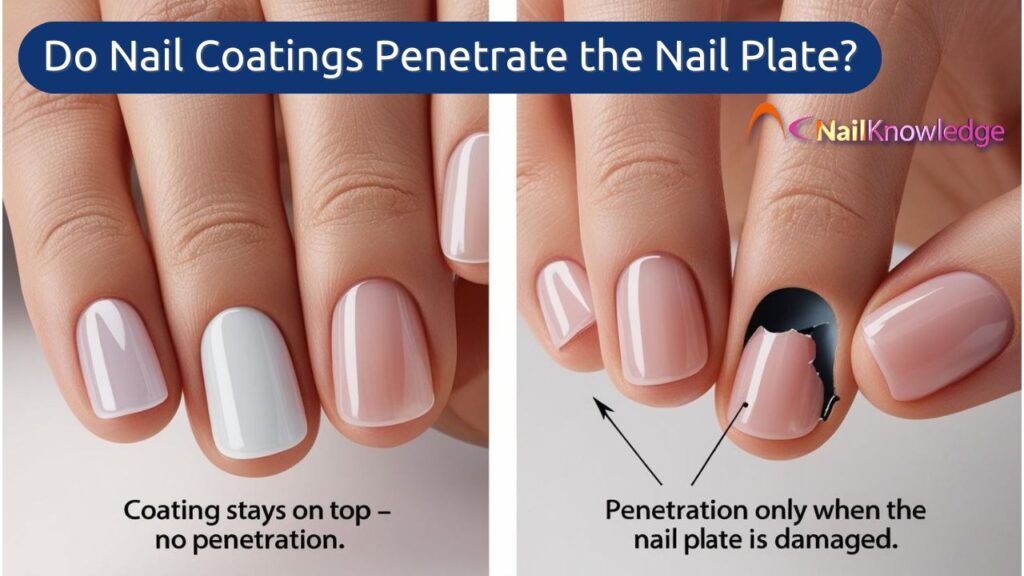We’ve all heard the chatter on social, in salons, maybe even whispered in the corner of a nail tech class. “Gels seep into the nail bed.” “Acrylics cause lifting from the inside out.” But hold up, ¿Es eso cierto? If you’ve ever paused mid-mani and wondered, Do nail coatings penetrate the nail plate?, you’re not alone. This question has sparked confusion, myths, and worry for nail enthusiasts and pros alike.
So let’s break it down together, science meets real talk style.
Qué incluso Es ¿la placa ungueal?
Before we get into the juicy myth-busting, let’s take a hot second to appreciate the nail plate. Think of it like a security guard for your lecho ungueal, it’s strong, smart, and surprisingly picky about what it lets through.
The nail plate is the visible, hard part of your nail. It’s made up of tightly packed keratin cells (like your hair, but flatter and harder) and acts as a natural barrier, guarding the sensitive nail bed beneath from outside elements, including chemicals. But here’s the wild part, it’s semipermeable. Permite agua pasan fácilmente, ¿pero casi todo lo demás? Buena suerte superando ese muro de queratina.
Incluso los aceites de uñas, sí, los buenos que te aplicas religiosamente, tienen dificultades para ir más allá de la superficie. Los estudios demuestran que necesitan un mes o más de aplicación diaria just to reach the top 10% of the plate. That’s persistence!
¿Penetran los esmaltes en la lámina ungueal?
Spoiler: No en uñas sanas.
Let’s get to the heart of it: ¿Penetran los recubrimientos de uñas en la lámina ungueal?
¿La respuesta corta? No. No si la placa ungueal está intacta y sana.
Whether it’s UV gels, builder in a bottle, dip powders, or acrylic overlays, they all sit on top of the nail plate. They’re designed to adhere to the surface, not sink into it. The myth that they burrow down to the nail bed and wreak havoc? That’s more fiction than fact.
Onycholysis, the term for when the nail lifts from the bed does happen, but coatings aren’t the villain in a typical scenario. The real culprits? Things like:
- Relleno excesivo de la lámina ungueal
- Usar demasiada presión al preparar
- Harsh trauma (hello, stiletto nail stub!)
- Determinados medicamentos o problemas de salud
In other words, it’s not the product going rogue, it’s usually what’s done antes de o en torno a el producto que causa problemas.
Pero ¿qué Si ¿Está dañada la lámina ungueal?
Now, let’s be real. Not all las placas de uñas están en perfecto estado. We’ve all been there, peeling off gel (don’t judge), over-filing to remove a stubborn top coat, or dealing with breakage. So what happens if the nail plate is agrietado, rotoo limado demasiado fino?
That’s when things get a little dicey.
When the nail plate’s natural barrier is compromised, the coatings you apply could potencialmente reach the skin underneath. That exposure might lead to irritation, allergic reactions, or in rare cases, trigger onycholysis. Think of it like a roof with a hole, water wasn’t a problem before, but now the couch is soaked.
The key takeaway? If the nail plate is damaged, even the most gentle product can cause a reaction, not because it’s inherently “bad,” but because it’s going somewhere it was never supposed to go.
Recubrimientos de uñas = Jugadores de superficie, no buceadores profundos
Let’s go back to basics: Coatings are designed to be arriba. They bond with the surface keratin, not beneath it. They’re like the perfect topcoat to a stylish outfit. Decorative? Absolutely. Protective? Often. But invasive? Nope.
When people say, “This product caused damage,” what they often mean is:
- La preparación era demasiado agresiva.
- The removal process wasn’t gentle.
- Las uñas ya estaban comprometidas antes de aplicar el producto.
The product didn’t tunnel its way to the nail bed like a villain in a spy movie, it just did what it was told, on the surface.
Uñas sanas = Recubrimientos felices
Entonces, ¿cómo mantener el buen rollo entre nuestras uñas y nuestros productos favoritos?
- Evite archivar en exceso. Mantén esa capa protectora fuerte y feliz.
- Mantén unas uñas sanas. Don’t apply coatings to damaged, inflamed, or thinning nails.
- Tenga paciencia con la retirada. Cautiously soak, rebalance but don’t rip.
- Hidrata tus uñas. Even if oils don’t go deep, they help prevent brittleness and keep the top layers flexible.
Proteger la integridad de la lámina ungueal significa dar a sus recubrimientos la mejor superficie para brillar, literal y figuradamente.
Reflexiones finales: Saber la verdad, acertar
Let’s wrap this up like a glossy topcoat:
¿Penetran los recubrimientos de uñas en la lámina ungueal? No, a menos que la placa de la uña se haya visto comprometida (lo cual es fácil). Así que, si se usan correctamente, con una buena preparación y unas uñas sanas, los geles, acrílicos y superposiciones son una belleza superficial, no invasores secretos.
So the next time someone tells you that gel “seeps into your nail bed,” you can raise an eyebrow and say, “Actually, that’s not how the nail plate works.” 💁♀️
💅 Consejo del día para las uñas:
If you wouldn’t sand your skin, don’t sand your nails. Un toque suave = uñas más fuertes y manicuras más duraderas.


